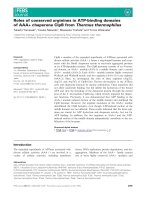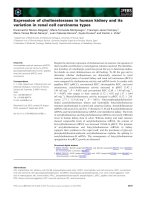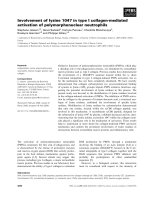Báo cáo khoa học: "Expression of apxIA of Actinobacillus pleuropneumoniae in Saccharomyces cerevisiae" docx
Bạn đang xem bản rút gọn của tài liệu. Xem và tải ngay bản đầy đủ của tài liệu tại đây (303.96 KB, 4 trang )
-2851$/ 2)
9H W H U L Q D U \
6FLHQFH
J. Vet. Sci.
(2003),
/
4
(3), 225–228
Expression of
apx
IA of
Actinobacillus pleuropneumoniae
in
Saccharomyces cerevisiae
Sung Jae Shin, Jong Lye Bae
1
, Young Wook Cho, Moon Sik Yang
1
, Dae Hyuk Kim
1
,
Yong Suk Jang
1
and Han Sang Yoo*
Department of Infectious Diseases, College of Veterinary Medicine and School of Agricultural Biotechnology,
Seoul National University, Seoul, 151-742, Korea
1
Division of Biological Sciences and the Institute for Molecular Biology and Genetics, Chonbuk National University,
Chonju, 561-756, Korea
Actinobacillus pleuropneumoniae
is an important
primary pathogen in pigs, in which it causes a highly
contagious pleuropneumoniae. In our previous study,
apx
IA gene amplified from
A. pleuropneumoniae
Korean
isolate by PCR with primer designed based on the N- and
C-terminal of the toxin was cloned in TA cloning vector
and sequenced. The nucleotide sequences of
apx
IA gene
was reported to GeneBank with the accession numbers of
AF363361. Identity of the Apx IA from the cloned gene in
E. coli
was proved by SDS-PAGE and Western blot. Yeast
has been demonstrated to be an excellent host for the
expression of recombinant proteins with uses in
diagnostics, therapeutics and vaccine productions.
Therefore, to use the yeast as a delivery system in new oral
subunit vaccine,
apx
IA gene was subcloned into
Saccharomyces cerevisiae
, and identified the expression of
Apx IA protein.
First,
apx
IA gene was amplified by PCR
with the primers containing
Bam
HI and
Sal
I site at each
end. Second, the DNA digested with
Bam
HI and
Sal
I was
ligated into YEpGPD-TER vector, and transformed into
S. cerevisiae
2805. Third, after identification of the
correctly oriented clone, the 120-kDa of Apx IA protein
expressed in
S
.
cerevisiae
2805 was identified by SDS-
PAGE and Western blot.
Key words:
Actinobacillus pleuropneumoniae
,
apx
IA,
expression,
Saccharomyces cerevisiae
Introduction
Porcine pleuropneumoniae caused by
Actinobacillus
pleuropneumoniae
is a contagious, fibrinous, hemorrhagic,
and necrotizing disease that results in high mortality in
acutely infected pigs, or localized small lung lesions in
chronically infected ones [5,6,13]. A number of potential
virulence factors have been identified in
A.
pleuropneumoniae
, including a family of secreted toxins,
or Apx toxins, which are members of the RTX (Repeat in
ToXins) toxin family. Importance of Apx toxins in
A.
pleuropneumoniae
virulence was demonstrated with
several different mutants such as spontaneous, chemically
induced, and transposon mutagenesis [1,7,8,14,16,23]. To
date, 15 serotypes, which secrete different combinations of
four cytotoxins belonging to the RTX toxin family, Apx I,
Apx II, Apx III and Apx IV have been described [4,10,17].
Regional difference in the prevalence of serotypes and
toxinotypes were reported [12,13]. The most prevalent
serotypes in Korea are in the order of 2, 5 and 6 [12].
Although the virulence of
A. pleurpneumoniae
is
multifactorial, studies indicate that virulence is strongly
correlated with the production of Apx exotoxins, with
serovars producing Apx I and Apx II being the most
virulent [7,14,16,23]. At present, no identified serovars of
A. pleuropneumoniae
were found to produce all four Apx
toxins, with the majority producing only two. Apx IA
named hemolysin I (Hly I) or cytolysin I (Cly I) is
produced by serotypes 1, 5, 9, 10 and 11. This protein is
strongly hemolytic and shows strong cytotoxic activity
toward porcine macrophages and neutrophils [9].
Production and secretion of active RTX toxins require
the activity of four genes,
apxC, -A, -B,
and -
D
[5,7,20].
The
apx
A gene encodes the structural toxin, whereas the
apx
C gene encodes a posttranslational activator, which is
involved in the transfer of a fatty acyl group from an acyl
carrier protein to the structural toxin. Activation of ApxA
is required for target cell-binding. The
apx
B and
apx
D
genes encode proteins that are required for the secretion of
activated toxin. Apx I and Apx III are encoded by operons
that consist of four contagious genes (
-C, -A, -B, -D
)
*Corresponding author
Phone: +82-2-880-1263; Fax: +82-2-874-2738
E-mail :
226 Sung-jae Shin
et al.
expressed from a single promoter located 5’ of the
apx
C
gene [7].
The effective controls of diseases are depending on
vaccinations and antibiotic therapies which are based on
injectable forms so far. However, these methods still pose
problems such as induction and spreading of antibiotic
resistance, presence of antibiotic residues in slaughter pigs,
vaccination side effects, labor-intensive vaccination
procedures, development of the carrier state [25,26].
Therefore, recent vaccine development has been strongly
focused more on the development of oral vaccines.
Saccharomyces cerevisiae
has been part of our diet for
centuries without adverse effects and is also considered to
be superior to bacterial systems in respect to production of
recombinant proteins in a conformation that more closely
resembles that of native proteins [2,18].
Therefore, we attempted to develop an oral vaccine as a
new trial to control porcine pleuropneumonia and, at the
same time, minimize the problems following injection as
low as possible.
As the first step of development of a new subunit
vaccine,
apx
IA gene was amplified from
A.
pleuropneumoniae
serotype 5 isolated from Korea by PCR
with primer designed based on the N- and C-terminal of
the toxin [21]. Also, Apx IA protein was expressed using
E. coli
system and yeast
Saccharomyces cerevisiae
then,
the expressed proteins was identified by using SDS-PAGE
and Western blot.
Materials and Methods
Bacterial strains and vectors
A. pleuropneumoniae
serotypes 5 isolated from lungs of
Korean pigs with pleuropneumonia was used for the
cloning of
apx
IA gene as previously described [21].
E. coli
Top 10 and M15 and
S. cerevisiae
2805 were used as hosts
for transformation and expression of the recombinant Apx
IA. TOPO, pBluescript IIKS (+), and pQE31 for
E. coli,
and YEpGPD for
S. cerevisiae
were used as vectors for
cloning and expression.
Cloning, subcloning of
A. pleuropneumoniae
apx
IA
gene
apx
IA gene was amplified by PCR with primers
designed based on the sequence from GenBank (Accession
no. D16582), and cloned with TOPO cloning vector kit
(Invitrogen) after purification of the amplified PCR
products from agarose gel using Gel extraction-QIA quick
Gel extraction Kit (Qiagen). The primers used for
apx
IA
gene amplification were forward 5'-GGATCCATGGCTA
ACTCTCAGCTCGAT-3' and reverse 5'-GGATCCTTAAG
CAGATTGTGTTAAATA-3'. PCR included 30 cycles of
denaturation at 94
o
C for 30 sec, annealing at 53
o
C for 30
sec, polymerization at 72
o
C for 3 min, and final
polymerization at 72
o
C for 7 min. The cloned gene was
analyzed using restriction enzymes,
Eco
RI,
Hind
III, and
Kpn
I (Gibco/BRL) and the correct clones were sequenced
using an automatic sequencer (ABI PRSIM 377XL).
To perform cloning in
S. cerevisiae
with YEpGPD,
appropriate enzyme sites were generated by subcloning
apx
IA gene with pBluescript II KS cloning vector into
E.
coli
Top 10. Briefly, 5 and 3 ends of
apx
IA gene were
blunted with Klenow fragment (Gibco/BRL) and cloned
with
Eco
RV-digested pBluecript II KS. Orientation of
inserted fragment was confirmed by digestion with
restriction endonucelases. Subsequently,
apx
IA of
pBlusecript II KS-
apx
IA was excised out through
digestion with restriction endonucelases,
Bam
HI and
Sal
I,
and ligated with the yeast expression vector, YEpGPD,
digested with same restriction enzymes. After ligation, the
yeast expression vector was transformed into the
expression host
S. cerevisiae
2805 using LiAc method
[15].
Expression of
apx
IA gene in
Saccharomyces cerevisiae
Transformed colonies were cultured onto selective
medium (URA
−
; yeast nitrogen base 6.7 g, casamino acid 5
g, glucose 20 g, adenine 0.03 g, tryptopan 0.03 g, and
bactoagar 20 g in 1000 ml of D.W.) for 12 hr, transferred
into basic medium (YEPD; yeast extract 10 g,
bactopeptone 20 g, and glucose 20 g in 1000 ml of D.W.)
and cultured until 0.6-0.7 at O.D.
600
for 2-3 days at 30
o
C.
The cells were then harvested, and cellular proteins were
extracted with an extraction buffer (Tris-HCl 50 mM,
glycerol 10%, EDTA 10 mM) and glass beads by vortexing
five times for 1 min. Extracted protein was collected by
centrifugation at 7,000 rpm for 5 min at 4
o
C and analyzed
by SDS-PAGE and Western blot using mono-specific
polyclonal antibody against rApx IA.
SDS-PAGE and Western blot
Proteins expressed in
E. coli
or extracted from yeast
S.
cerevisiae
2805 were analyzed by SDS-PAGE [11] and
Western blot [24] using mono-specific polyclonal antibody
against rApx IA. For SDS-PAGE, total proteins (10
µ
g)
from
S. cerevisiae
2805 harboring vector with
apx
IA gene
or only vector were treated with the sample buffer (60 mM
Tris-HCl, pH 6.8, 25% Glycerol, 2% SDS, 14.4 mM 2-
mercaptoethanol, 0.1% bromphenol blue) and
electrophoresed into 10% polyacrylamide gel at 20 mA for
2 hr. The gels were then stained with Coomassie brilliant
blue R-250.
For immunological analysis of expressed rApx IA
protein in
S. cerevisiae
, the proteins separated by SDS-
PAGE as described above were electrophoretically
transferred on to nitrocellulose membranes (Bio-Rad). The
NC membranes were incubated in 5% skim milk (Sigma
Co.) in Tris buffered saline (TBS, pH 7.5) for 2 hrs at 37
o
C.
Expression of
apx
IA of
Actinobacillus pleuropneumoniae
in
Saccharomyces cerevisiae
227
After washing three times with TBS, the membranes were
incubated with 1 : 500 diluted mono-specific mouse anti-
Apx IA antiserum for 2 hrs at room temperature. After the
immunoreaction, the membranes were washed again as
described above and then reacted with 1 : 7,000-diluted
alkaline phosphate conjugated goat anti-mouse IgG
antibody (Sigma). After removal of unreacted antibodies
by washing with TBS then immunoreactive bands were
visualized with an enhanced AP conjugate substrate kit
(Bio-Rad) in the dark.
Results
As the first step of development of a new subunit vaccine
using yeast expression system,
apx
IA gene was amplified
as a 3,069 bps PCR product from
A. pleuropneumoniae
isolated from Korea by PCR with primer designed based
on the N- and C-terminal of the toxin and the cloned gene
was sequenced, and the sequence was reported to
GenBank with Accession no. AF363361. Identity of the
cloned gene with reference strain was proved by
comparison of the nucleotide sequence and phylogenetic
analysis [21]. Identification of the expressed and purified
protein was also confirmed by SDS-PAGE and Western
blos analysis as previously described [21].
The cloned
apx
IA gene was successfully subcloned into
YEpGPD vector through pBluescript II KS (f) to generate
appropriate restriction enzyme sites (Fig. 1) and was
expressed in
S. cerevisiae
2805. To confirm the expression
of Apx IA protein in
S. cerevisiae
2805, SDS-PAGE and
Western blot were performed. The 120-kDa size of
expressed rApx IA protein in
S. cerevisiae
was detected as
same as size of Apx IA in SDS-PAGE analysis and
Western blot using mono-specific polyclonal antibody
against rApx IA expressed in
E. coli
(Fig. 2).
Discussion
Recombinant DNA technology, and in particular yeast
expression systems, have been successfully used to
produce antigens such as malaria antigens, hepatitis B
virus surface antigens [2,18]. Also, recombinant proteins
can be produced from yeast in large quantities and at low
cost with the possibility of widespread immunization
compared with bacterial expression systems [2,19].
S. cerevisiae
has been considered to be safe as diet in
human without any side effects. It has a generally regarded
as safe (GRAS) status and is generally a good expression
system for heterologous proteins. Therefore, it has been
legally used in food and pharmaceutical productions [18].
In addition, it has been used as tracer for the oral
application of vaccines and drugs because it is relatively
stable, nonpathogenic and noninvasive in gut compared to
other biodegradable vehicles [3]. Also, cellular
components of yeast such as
β
-glucan have
immunostimulatory effects that might be beneficial when it
works as adjuvant for the induction of broad-based cellular
immune responses [2,22].
Therefore, with the development of yeast expressing
Apx IA exotoxin,
S. cerevisiae
might be a useful delivery
system for the prevention of porcine pleuropneumonia and
the results obtained in this study could be used for the
future study to develop a new oral vaccine to porcine
pleuropneumonia.
F
ig. 1. Diagram of YEpGPD-
apx
IA for the expression of
apx
I
A
g
ene in
Saccharomyces cerevisiae
.
F
ig. 2. Analysis of expressed Apx IA in
Saccharomyc
es
c
erevisiae
by 10% SDS-PAGE (A) and Western blot analysis (B
).
L
ane 1,
S. cerevisiae
containing YEpGPD-TER; lane 2,
S.
c
erevisiae
harboring YEpGPD-TER-
apx
IA; and lane M
,
m
olecular weight marker. Arrows (
←
) indicate the express
ed
r
ApxIA in
S. cerevisiae
.
228 Sung-jae Shin
et al.
Acknowledgments
This study was supported by Biogreen 21 Programs,
Brain Korea 21 Project, and the Research Institute for
Veterinary Science, Seoul National University, Korea.
References
1. Anderson, C., Potter, A. A. and Gerlach, G. F. Isolation
and molecular characterization of spontaneously occurring
cytolysin-negative mutants of
Actinobacillus
pleuropneumoniae
serotype 7. Infect. Immun. 1991, 59,
4110-4116.
2. Bathurst, I. C. Protein expression in yeast as an approach to
production of recombinant malaria antigens. Am. J. Trop.
Med. Hyg. 1994, 50, 11-19.
3. Beier, R. and Gebert, A. Kinetics of particle uptake in the
domes of Peyers patches. Am. J. Physio1. 1998, 275, 130-
137.
4. Blackall, P. J., Klaasen ,H. L. B. M., Van Den Bosch, H.,
Kuhnert, P. and Frey, J. Proposal of a new serovar of
Actinobacillus pleuropneumoniae
: serovar 15. Vet.
Microbiol. 2002, 84, 47-52.
5. Bosse, J. T., Janson, H., Sheehan, B. J., Beddek, A. J.,
Rycroft, A. N., Kroll, J. S. and Langford, P. R.
Actinobacillus pleuropneumoniae
: pathobiology and
pathogenesis of infection. Micro. Infect. 2002, 4, 225-235.
6. Chiers, K., Donne, E., Van Overbeke, I., Ducatelle, R. and
Haesebrouck, F.
Actinobacillus pleuropneumoniae
infections in closed swine herds: infection patterns and
serological profiles. Vet. Microbiol. 2002, 85, 343-352.
7. Frey, J. Virulence in
Actinobacillus pleuropneumoniae
and
RTX toxins. Trends Microbiol. 1995, 3, 257-261.
8. Fuller, T. E, Martin, S., Teel, J. F., Alaniz, G. R., Kennedy,
M. J. and Lowery, D. E. Identification of
Actinobacillus
pleuropneumoniae
virulence genes using signature-tagged
mutagenesis in a swine infection model. Microb. Pathog.
2000, 29, 39-51.
9. Kamp, E. M., Poma, J. K., Anakotta, J. and Smits, M. A.
Identification of hemolytic and cytotoxic proteins of
Actinobacillus pleuropneumoniae
by use of monoclonal
antibodies. Infec. Immun. 1991, 59, 3079-3085.
10. Komal, J. P. and Mittal, K. R. Grouping of
Actinobacillus
pleuropneumoniae
strains of serotypes 1 through 12 on the
basis of their virulence in mice. Vet. Microbiol. 1990, 25,
229-240.
11. Laemmli, U. K. Cleavage of structural proteins during the
assembly of the head of bacteriophage T4. Nature. 1970, 227,
680-685.
12. Min, K. and Chae, C. Serotype and
apx
genotype profiles of
Actinobacillus pleuropneumoniae
field isolates in Korea. Vet.
Rec. 1999, 145, 251-254.
13. Nielson, R. Seroepidemiology of
Actinobacillus
pleuropneumoniae
. Can. J. Vet. Res. 1998, 29, 580-582.
14. Prideaux, C. T., Lenghaus, C., Krywult, J. and Hodgson,
A. L. M. Vaccination and protection of pigs against
pleuropneumonia with a vaccine strain of
Actinobacillus
pleuropneumoniae
produced by site-specific mutagenesis of
the Apx II operon. Infect. Immun. 1999, 67, 1962-1966.
15. Prideaux, C. T., Pierce, L., Krywult, J. and Hodgson, A.
L. Protection of mice against challenge with homologous and
heterologous serovars of
Actinobacillus pleuropneumoniae
after live vaccination. Curr. Microbiol. 1998, 37, 324-332.
16. Reimer, D., Fery, J., Jansen, R., Veit, H. P. and Inzana, T.
J. Molecular investigation of the role of ApxI and ApxII in
the virulence of
Actinobacillus pleuropneumoniae
serotype
5. Microb. Pathog. 1995, 18, 197-209.
17. Schaller, A., Kuhn, R., Kuhnert, P., Nicolet, J.,
Anbderson, T. J, MacInnes, J. I., Segers, R. P. and Frey, J.
Characterization of
apx
IVA, a new RTX determinant of
Actinobacillus pleuropneumoniae
. Microbiology. 1999, 145,
2105-2116.
18. Schreuder, M. P., Deen, C., Boersma, W. J. A., Pouwels, P.
H. and Klis, F. M. Yeast expressing hepatitis B virus antigen
determinants on its surface: implications for a possible oral
vaccine. Vaccine. 1996, 14, 383-388.
19. Schreuder, M. P., Mooren, A. T. A., Toschka, H. Y.,
Verrips, T. C. and Klis, F. M. Immobilizing proteins on the
surface of yeast cells. Trends Biotechnol. 1996, 14, 115-120.
20. Seah, J. N., Frey, J. and Kwang, J. The N-terminal domain
of RTX toxin ApxI of
Actinobacillus pleuropneumoniae
elicits protective immunity in mice. Infect. Immun. 2002, 70,
6464-6467.
21. Shin, S. J., Cho, Y. W. and Yoo, H. S. Cloning, sequencing
and expression of
apx
IA, IIA, IIIA of Actinobacillus
pleuropneumoniae isolated in Korea. Korean J. Vet. Res.
2003, 43, 247-253.
22. Stubbs A. C., Martin, K. S., Coeshott, C., Skaates, S. V.,
Kuritzkes, D. R., Bellgrau, D., Franzusoff, A., Duke R. C.
and Wilson, C. C. Whole recombinant yeast vaccine
activates dendritic cells and elicits protective cell-mediated
immunity. Nat. Med. 2001, 7, 625-629.
23. Tascon, R. I., Vanquez-Boland, J. A, Gutierrez-Martin, C.
B, Rodriguez-Barbosa, I. and Rodriguez-Ferri, E. F. The
RTX haemolysin ApxI and ApxII are major virulence factors
of the swine pathogen
Actinobacillus pleuropneumoniae
:
evidence from mutational analysis. Mol. Microbiol. 1994, 14,
207-216.
24. Towbin, H., Staehelin, T. and Gorden, J. Electrophoretic
transfer of proteins from polyacrylamide gels to
nitrocellulose sheets: procedures and some applications.
Proc. Natl. Acad. Sci. USA 1979, 76, 4350-4354.
25. Vaillancourt, J. P., Higgins, R., Martineau, G. P., Mittal,
K. R. and Lariviere, S. Changes in the susceptibility of
Actinobacillus pleuropneumoniae
to antimicrobial agents in
Quebec (1981-1986). J. Am. Vet. Med. Assoc. 1998, 193,
470-473.
26. Van Overbeke, I., Chiers, K., Ducatelle, R. and
Haesebrouck, F. Effect of endobronchial challenge with
Actinobacillus pleuropneumoniae
serotype 9 of pigs
vaccinated with a vaccine containing Apx toxins and
transferrin-binding proteins. J. Vet. Med. B. 2001, 48, 15-20.
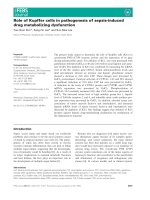


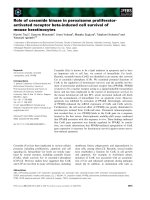

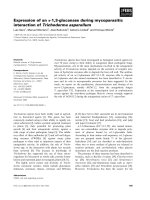
![Tài liệu Báo cáo khoa học: Expression of two [Fe]-hydrogenases in Chlamydomonas reinhardtii under anaerobic conditions doc](https://media.store123doc.com/images/document/14/br/hw/medium_hwm1392870031.jpg)
